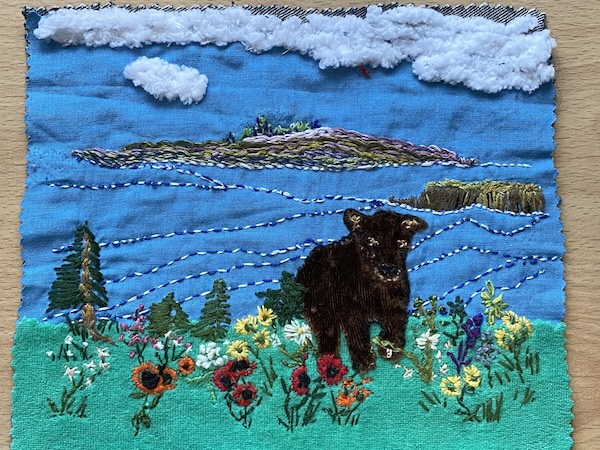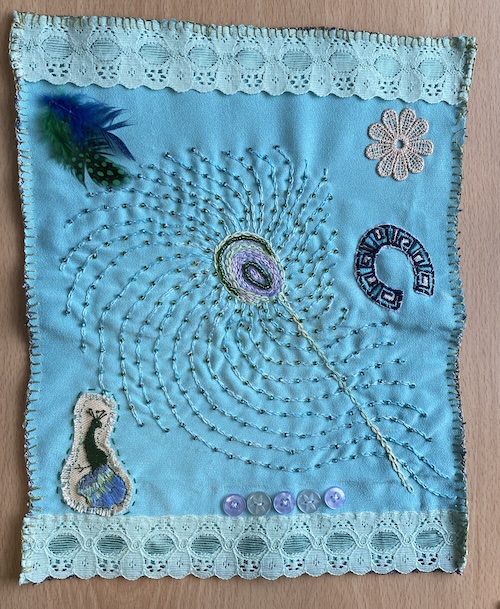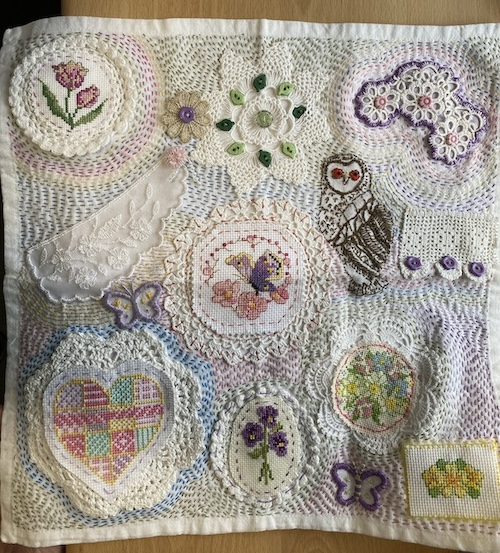- Home
- Slow Stitching
What is slow stitching?
“Slow stitching? Do you sew in slow motion or something?” my friend asked, grinning like I’d lost the plot.
I could have sent her a search link, but instead I told her what it means to me: not a method, but a mode. A way of making that celebrates surprise.
Think of the glossy kits sold in stores: a printed pattern, a neat color key, a predictable finish.
Slow stitching is the opposite.
No chart. No plan. Just a needle, fabric, thread, and curiosity. You start with an idea or a scrap and you let the work decide what comes next.
Perfection isn’t the point — discovery is. There’s a certain freedom in letting go of expectations and simply enjoying the process.
 This photo shows my mother's first attempt at slow stitching, capturing memories of a vacation on an uninhabited Scottish island.
This photo shows my mother's first attempt at slow stitching, capturing memories of a vacation on an uninhabited Scottish island.The Pleasure of Uncertainty
Every stitch belongs to the moment.
A loose running stitch might trace a remembered coastline; a cluster of French knots could become a sudden bloom.
Some stitches meander, some pile up into texture.
None need be perfect — their small irregularities are what give a piece its character.
There’s a rhythm to it: the soft click of the needle, the slight drag of thread across worn cotton, the smell of thrifted fabric warmed by your hands. Those small sensory details turn stitching into a kind of meditation. You come for the making and stay for the quiet.
 Shirley added beads in between her running stitches to echo the shape of her embroidered peacock feather
Shirley added beads in between her running stitches to echo the shape of her embroidered peacock featherTradition and repair
Slow stitching sounds new, but its roots run deep.
Look at sashiko: an old Japanese technique where running stitches mended and reinforced garments until they became decorative patterns.
Worn textiles were reborn; patched cloths gained history. Boro, patched, lovingly repaired fabrics, celebrates that same idea. Utility folded into beauty.
When I stitch scraps together, I’m part of that lineage. I treat seams like maplines and mistakes like places to add colour. Repurposing old embroidery, crocheted motifs, or shirts with a stain where it showed, turns waste into warmth and memory.
 Shirley repurposed cross stitch and crochet motifs by surrounding them with running stitch
Shirley repurposed cross stitch and crochet motifs by surrounding them with running stitchGetting started with slow stitching (no rules required)
One of the joys of slow stitching is how little you need.
Choose fabrics that feel good in your hands, cotton, linen, even loosely woven wool.
Contrast matters: a bolder scrap will pop against a neutral backing. Pick two or three threads you love. That’s it.
A few practical tips I use:
- Tacking: long, loose basting stitches to hold pieces in place. I put more thread on the back than the front so the front stays light.
- Stitches to try: running stitch (your bread-and-butter), French knot (tiny texture), chain stitch (a soft outline), satin stitch (for a solid fill).
- No glue?: you can use spray adhesive, but I prefer the tactileness of stitching everything down - it keeps the process slow and satisfying.
Micro project — Memory Square (20–30 minutes)
Materials:
- one 8" backing scrap
- 2–3 small fabric scraps
- embroidery needle
- two colors of thread
Steps:
- Loosely tack scraps to the backing.
- Outline one scrap with running stitch.
- Add a small cluster of French knots as an accent.
Stop. Admire. You’ve started a slow stitch piece.
Want to add to it?
Tip your scraps onto a table, run your fingers over them without looking, and let the feel of them guide you.
Add a piece where you think it works. Tuck something under the edge, Hold them together with a group of stitches that add colour or texture.
Using old embroidery
Turn motifs into anchors. A tiny cross-stitch square becomes the center of a stitched landscape if you surround it with running stitches and hand-stitched hills.
Repurpose granny-square crochet by stitching it onto a backing and echoing the colors with simple lines. If something looks odd, stitch over it. Texture hides a multitude of sins.
What to do with finished pieces
A finished panel can be a wall tile, a patch on a tote, or a pocket that carries small objects.
Sometimes I sew several squares together into a cushion or tote; sometimes I leave a piece as-is and let people touch it.
The value isn’t in impressing anyone, it’s in having a physical record of time spent and attention given.
If you’re curious to see how it all comes together, I’ve recorded a video of one of my slow stitching projects. Below is the final front cover I created in the video.

The quiet benefits
Slow stitching calms a busy mind.
The small decisions — which thread, which stitch — focus the attention without demanding perfection.
Using recycled materials adds another reward: your work becomes both creative and sustainable.
And because there’s no right finish, anyone can begin. Ten minutes is enough to start.
If you want a simple invitation: tonight, take one scrap from a worn shirt, two colors of thread, and make ten minutes of running stitches. No camera, no audience — just thread and time.
🧵 Your questions answered
 This is how the other piece shown in the video turned out
This is how the other piece shown in the video turned out
Stay connected between projects
If you’d like occasional updates from my embroidery room, including new patterns, gentle tips, and little things I think you might enjoy, you’re warmly invited to join the Stitchin’ Times newsletter.
No pressure. Just a friendly note now and then to keep you inspired.
